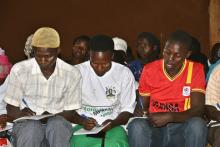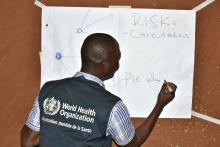Village Health Teams Contribute Tremendously to the Marburg Response in Eastern Uganda
Moses (not real name) is a resident of Kaproron, in Kween district, which has been experiencing the Marburg Virus Disease (MV) outbreak. Like many residents of the district, Moses had never heard of MVD before.
“Honestly, I had never heard of Marburg,” he says adding that “in fact, had it not been the Village Health Teams (VHTs) working in my area, I would have taken a long time to know all the facts about the disease. In fact until recently to Moses and many of his village mates, MVD was nonexistent but just witchcraft. Many believed the Ministry of Health (MoH) and partners “manufactured MVD to make some money”.
Today, the situation is different thanks to the intensified activities of VHTs, volunteers and technical people who have been operating in the communities of Kween and Kapchorwa district. “We have implemented enhanced community engagement, surveillance, social mobilization, communication and active case search and reporting”, said Dr Alan Muruta the Assistant Commissioner for National Disease Control at the MoH. “Success has depended on the health workers winning the trust of the community, which required the involvement of VHTs to penetrate the community and win their trust.
The VHTs didn’t know about MVD either. This is because VHTs are community laypersons who volunteer to mobilize and educate the community in which they stay on health and other social issues. Therefore, their knowledge of MVD was not any better than Moses’ meaning the MoH and partners had to start by building their capacity to be able to operate.
In this outbreak, 992 VHTs were trained on Risk Communication for MVD. They have reached individuals, households and communities through counselling, home visits and community dialogue sessions. They have also helped with surveillance, active case search and referral of patients to health facilities.
Most importantly, VHTs helped frontline health workers to address community resistance that was experienced in the early stages of the outbreak. “The communities were at first very suspicious of the Ministry officials and partners, especially when they went into the communities”, lamented one VHT member. There was active resistance that was overcome through the intervention of VHTs, religious and clan leaders and other community-based groups.
VHTs in Kween and Kapchorwa are now better able to respond not only to MVD but also to other outbreaks and emergencies that may occur in future. “We applaud and acknowledge the role of the VHTs in the current response to MVD. They know the communities, they are trusted more than the formal health workers and therefore invaluable, says Dr Emmanuel Tenywa, Team Lead of WHO interventions in Kween and Kapchorwa.
Currently, the number of alerts on the MTrac surveillance platform, as well as community referrals, have increased and this is partly attributable to the activities of the VHTs. Community education and mobilization by the VHTs still continue and the number of people who are knowledgeable and complying with MVD preventions and control messages such as Moses has increased throughout the district.





